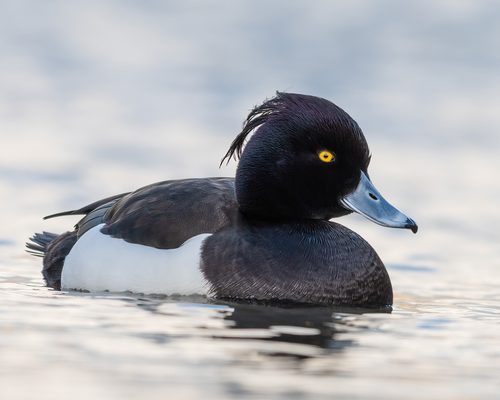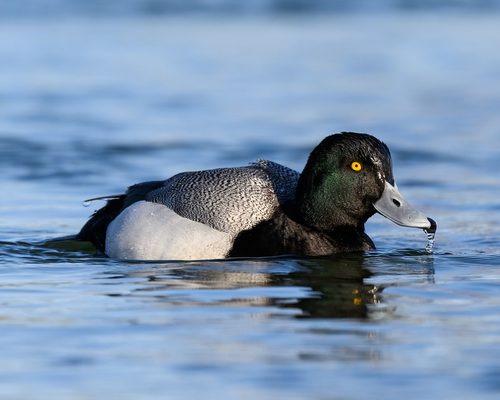Pochard
VulnerableAythya ferina
Visual Identification
Appearance
The Pochard is a medium-sized diving duck with a distinctive rounded head and sloping forehead. Males in breeding plumage have a striking rusty-red head, black breast, and pale grey body. Their back is finely vermiculated grey, creating a subtle, elegant pattern.
The drake’s winter plumage is bold and striking with a pale grey body, darker grey upperwing coverts and paler grey flight feathers. In eclipse plumage, males are similar to females but have greyer bodies, darker breasts and a plain face.
Females are more subdued, with a brown head and body and slightly paler cheeks. Both sexes have a grey bill with a black tip and grey legs. In flight, both show a pale grey wing stripe.
Size
Length
42cm to 49cm
Wingspan
67cm to 75cm
Weight
690g to 1.2kg
Habitat and Distribution
Habitats
Woodland
Garden
Wetland
Coastal
Urban
Farmland
Grassland
Desert
Tundra
Rainforest
Mountain
Savanna
Distribution
Pochards inhabit a variety of freshwater habitats, including lakes, reservoirs, and slow-flowing rivers with abundant aquatic vegetation. They breed across Europe and Asia, from Britain to eastern Siberia.
In winter, many birds migrate south to the Mediterranean, North Africa, and southern Asia. In the UK, they are year-round residents, with numbers boosted by winter visitors from northern Europe.
Elevation Range
Up to 2,690 meters
Climate zones
Temperate, Subarctic
Distribution Map
This map gives you a rough idea of where you might spot a Pochard. The coloured areas show countries where these birds have been seen.
A few things to keep in mind:
- Birds might not be everywhere in the coloured areas, for example, they may be present around the coast of that country
- Where birds live can change with seasons and available food
- This map is quite simple - it doesn't show exact locations
We're working on making our maps even better! Soon, we hope to show you:
- More detailed maps for bigger countries, including state and region
- How birds move around during different seasons
Distribution by Region
Behaviour and Ecology
Bird Attributes
This feature is in beta. We'd love your feedback to improve it!
Share your thoughtsBird Attributes Explained
Our bird attributes system rates various aspects of a bird's capabilities on a scale of 0-100, based on data from field observations, scientific studies, and expert knowledge.
Attribute Categories:
- Agility: Manoeuvrability, speed, and grace in flight or movement.
- Strength: Physical power, often correlating with size and hunting abilities.
- Adaptability: Ability to thrive in various environments or changing conditions.
- Aggressiveness: Territorial behaviour and assertiveness, particularly during breeding seasons.
- Endurance: Stamina, often seen in migration patterns or foraging behaviours.
Understanding the Ratings:
- 0-20: Very Low
- 21-40: Low
- 41-60: Average
- 61-80: High
- 81-100: Very High
Remember, these attributes are relative to other bird species and don't necessarily indicate superiority.
Hover over the icon next to each attribute for more information.
Tap the icon next to each attribute for more information.
Agility
Reflects the bird's manoeuvrability, speed, and grace in flight or movement.
The Pochard demonstrates high agility, particularly in its aquatic environment. Its ability to dive to depths of up to 3 metres and manoeuvre underwater for 15-30 seconds showcases impressive agility. The bird's special foot adaptation for efficient underwater propulsion further supports this rating.
Strength
Indicates the bird's physical power, often correlating with size and hunting abilities.
While not exceptionally strong for its size, the Pochard possesses moderate strength. Its ability to dive repeatedly and propel itself underwater indicates a reasonable level of muscular power. However, as a medium-sized duck, it's not among the strongest birds.
Adaptability
Represents the bird's ability to thrive in various environments or changing conditions.
Pochards show good adaptability. They can thrive in various freshwater habitats, from lakes to slow-flowing rivers, and at elevations up to 2,690 metres. Their ability to adjust their diet to include invasive species like zebra mussels demonstrates adaptability. However, their vulnerability to habitat loss slightly lowers this score.
Aggressiveness
Measures the bird's territorial behaviour and assertiveness, particularly during breeding seasons.
Pochards are not particularly aggressive birds. They form large, mixed flocks in winter, suggesting a relatively peaceful nature. Their courtship behaviour focuses on displays rather than aggressive competition. However, like most birds, they likely defend their nests, hence the moderate score.
Endurance
Reflects the bird's stamina, often seen in migration patterns or foraging behaviours.
The Pochard exhibits good endurance, particularly in its aquatic activities. Its ability to dive frequently for food and migrate long distances (for some populations) indicates strong endurance. The fact that some individuals live up to 15 years in the wild also suggests good overall stamina.
Diet
Pochards primarily feed on aquatic plants, seeds, and small invertebrates. They dive to depths of 1-3 meters to forage, using their broad bills to filter food from the water and mud.
In some areas, they have adapted to feed on zebra mussels, an invasive species. They are also frequently a nocturnal feeder.
Behaviour
Pochards are skilled divers, often submerging themselves for 15-30 seconds to forage. During winter, they form large flocks on open water, sometimes mixing with other diving ducks.
During the breeding season, males perform head-throws and whistling calls to attract mates.
Vocalisation
Pochards are generally quiet outside the breeding season. During courtship, males produce a soft, wheezing whistle, often described as 'wee-oo'. Females make a low, grating 'karr' sound. In flight, the wings produce a distinctive whistling noise.
Nesting & Breeding
Pochard breeding season typically begins in late April or May. Males court females with elaborate displays, including head-throws and whistling calls. Pairs often form new bonds each year.
Nests are built close to water, usually hidden in dense vegetation. The female constructs a shallow bowl of plant material lined with down and lays 8-10 olive-grey eggs.
Incubation lasts about 25 days and is carried out solely by the female. Ducklings are precocial, able to swim and feed themselves shortly after hatching, but they remain with their mother for protection for several weeks.
Lifespan
The Pochard typically lives for 10 to 12 years, with a maximum recorded lifespan of 23 years.
Like all birds, lifespan can be affected by factors including predation, habitat quality, disease, and access to food sources.
Conservation and Status
Global Conservation Status
The Pochard is classified as Vulnerable due to significant population declines across its range. Threats include habitat loss, particularly the drainage of wetlands, hunting, and climate change impacts. Conservation efforts focus on protecting and restoring wetland habitats.
Birdwatching Tips
- Look for Pochards on large, open bodies of freshwater, especially in winter.
- Observe their diving behaviour - they submerge completely, unlike dabbling ducks.
- In the UK, visit wetland reserves like Rutland Water or the London Wetland Centre for good viewing opportunities.
- Listen for the male's distinctive whistling call during the breeding season.
- Spring and summer are the best times to spot Pochards as the male is in its clearly defined breeding plumage, which is easily recognisable.
Additional Information
Quick Facts
Other names:
Common Pochard, Eurasian Pochard
Family:
AnatidaePredators
Did You Know?
- Pochards can dive to depths of up to 3 meters to forage for food.
- They have a special adaptation in their feet that allows them to efficiently propel themselves underwater.
- Some Pochard populations have shifted their wintering grounds northward due to climate change.
Was this bird profile helpful?
Your feedback helps us improve our content
Thanks for your feedback!
Your input helps us improve our content.
Community Experience
Community Ratings
No ratings yet - be the first to rate this bird!
Latest Community Reviews
No reviews yet
Sign in to be the first to review
Community Reviews
Create Your Free Account Welcome Back!
Join our community to rate birds and share your experiences. Creating an account is completely free and only takes a minute. Sign in to your account to rate birds and share your experiences with our community.
Your information is secure and will never be shared.
By creating an account, you agree to our Privacy Policy.
Similar Birds
References
- 2
website: BirdLife International. 2021. Aythya ferina. The IUCN Red List of Threatened Species 2021: e.T22680358A205288455.
View source - 3 4
report, 2021: Wetlands International
- 1
website, 2010: Fransson et al., EURING list of longevity records for European birds
View source

